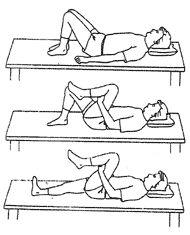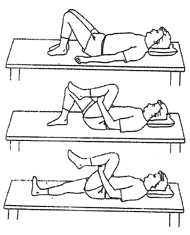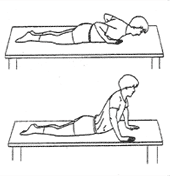Low Back Pain
What Is Low Back Pain?
Low back pain is pain and stiffness in the lower back. It affects 80% of the population during one point in their life time. It is the leading reason why people miss work. It can have a slow gradual onset, or a sudden onset. Low back pain will usually resolve on its own within a few days, if it persists one should seek medical attention.
How Does It Occur?
Low back pain is caused by mechanical strain. This occurs when the joints in our spine are placed in a position that over stretches the surrounding ligaments and other soft tissues. This can occur with repeated stress, or sudden stress such as a trauma.
It is often thought that lower back pain is caused by a strained muscle. Muscles, which are the source of power and cause movement, can be over stretched and injured. This however, requires a considerable amount of force and does not happen often. Moreover, muscles usually heal very rapidly and seldom cause pain lasting greater than a week or two. However, when the impact of the injuring force is severe enough to affect the muscles, the underlying soft tissues and ligaments will be damaged as well. Damage to the tissues can occur with such forces as a car accident, an event during a contact sport, or a fall.
Pain produced from over-stretching is very common and can arise particularly when we develop poor postural habits. Whenever we remain in a relaxed position, be it standing, sitting, or lying, prolonged over stretching can occur resulting in increased pain.
Pain can be made worse from excessive bending, lifting, and twisting. It can even be brought on by a cough or a sneeze.
People who are overweight may have a more difficult time healing after the onset of low back pain, but it is usually not the cause of the problem.
Back pain accompanied by a loss of bladder or bowel control, difficulty in moving your legs, or numbness or tingling in your legs may indicate a more serious injury to your spine involving the nerves. You should seek immediate medical attention from your physician if any of these symptoms are present.
Most importantly, don’t delay proper medical attention and/or treatment. Low back pain responds very well to appropriate conservative treatment such as physical therapy and proper medication which can be prescribed by your physician.
What Are The Symptoms?
Symptoms include:
- Pain in the back or legs.
- Stiffness and limited motion.
- May include difficulty sitting or walking.
Pain that seems to be progressively moving down the leg and away from midline of the spine is a sign of worsening symptoms. Pain that is moving to a more central location toward the spine is a good sign, and a sign of improvement. Therefore, activities that cause the pain to move further down the leg should be avoided.
When low back pain produces pain, numbness, and/or tingling past the knee into the calf or foot, the nerve may be involved. When you have weakness in your leg, especially if you cannot lift your foot, this could be a sign of a more severe nerve involvement. New bowel or bladder problems related to your back pain may indicate a more severe injury, as well as increasing symptoms despite treatment.
When these symptoms occur, it may indicate disc involvement, severe degenerative changes resulting in nerve compression, or other spinal conditions. Be sure to see your doctor when these symptoms are occurring.
How Is It Diagnosed?
Low back pain can be diagnosed by a review of your medical history and clinical exam. Your doctor may order specific diagnostic tests if the symptoms do not improve in a few weeks with conservative treatment. Some of these tests might be: x-rays, CT scan, MRI, myelogram, or EMG. Your doctor will know which test is best for you. Your doctor may refer you to physical therapy, or to specialist such as an orthopedic physician, or a neurosurgeon.
How Is It Treated?
Low back pain varies between individuals. The treatment that is best for you can only be determined after a thorough evaluation by your physician, and physical therapist.
Some common treatment recommendations that may help are the following:
- Ice pack applied to the low back, best if applied acutely for pain (first 72 hrs.)
- Moist heat applied to the low back area.
- Rest as needed lying in the position most comfortable for you:
- Lie on your back with a pillow under your knees and a flat pillow under your head.
- Lie on your side with a pillow between your knees, keep your knees below your hips, and avoid the fetal position.
- Lie flat on your stomach with no pillow, or one very flat pillow under your head.
- Medication as prescribed by your doctor.
- Begin a walking program.
- Avoid lifting, bending, and twisting.
- Always sit straight and use lumbar support if you tend to sit for long periods.
- Move about to stay comfortable, avoid static postures.
- Physical therapy
The following stretches may help, but should be discontinued if your symptoms increase. This information should not take the place of seeking medical attention from your doctor, or the recommendations of a physical therapist after an evaluation of your particular problem. Remember, all back conditions are individual and no two are completely alike. The best way to treat your problem conservatively is to seek the attention of a physical therapist for specific exercises for your problem. Your doctor will help you accomplish this.
Lower Back Exercise
In general, if your back feels better when you sit and/or bend, these stretches are best for your particular problem:

Trunk Flexion – Single Knee to Chest

Trunk Flexion – Double Knee to Chest
If your back feels better when you are walking and/or standing, these stretches are best for your particular back problem:

Trunk Extension – Prone on Elbows

Trunk Extension – Press-Up

Trunk Extension – Backends
* STOP EXERCISING AND SEEK THE EXPERTISE OF A PHYSICAL THERAPIST IF YOUR PAIN INCREASES OR WORSENS.
